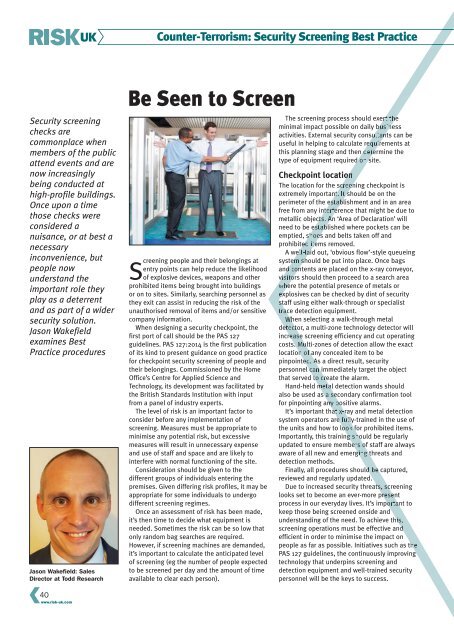RiskUKOctober2017
Create successful ePaper yourself
Turn your PDF publications into a flip-book with our unique Google optimized e-Paper software.
Counter-Terrorism: Security Screening Best Practice<br />
Security screening<br />
checks are<br />
commonplace when<br />
members of the public<br />
attend events and are<br />
now increasingly<br />
being conducted at<br />
high-profile buildings.<br />
Once upon a time<br />
those checks were<br />
considered a<br />
nuisance, or at best a<br />
necessary<br />
inconvenience, but<br />
people now<br />
understand the<br />
important role they<br />
play as a deterrent<br />
and as part of a wider<br />
security solution.<br />
Jason Wakefield<br />
examines Best<br />
Practice procedures<br />
Jason Wakefield: Sales<br />
Director at Todd Research<br />
Be Seen to Screen<br />
Screening people and their belongings at<br />
entry points can help reduce the likelihood<br />
of explosive devices, weapons and other<br />
prohibited items being brought into buildings<br />
or on to sites. Similarly, searching personnel as<br />
they exit can assist in reducing the risk of the<br />
unauthorised removal of items and/or sensitive<br />
company information.<br />
When designing a security checkpoint, the<br />
first port of call should be the PAS 127<br />
guidelines. PAS 127:2014 is the first publication<br />
of its kind to present guidance on good practice<br />
for checkpoint security screening of people and<br />
their belongings. Commissioned by the Home<br />
Office’s Centre for Applied Science and<br />
Technology, its development was facilitated by<br />
the British Standards Institution with input<br />
from a panel of industry experts.<br />
The level of risk is an important factor to<br />
consider before any implementation of<br />
screening. Measures must be appropriate to<br />
minimise any potential risk, but excessive<br />
measures will result in unnecessary expense<br />
and use of staff and space and are likely to<br />
interfere with normal functioning of the site.<br />
Consideration should be given to the<br />
different groups of individuals entering the<br />
premises. Given differing risk profiles, it may be<br />
appropriate for some individuals to undergo<br />
different screening regimes.<br />
Once an assessment of risk has been made,<br />
it’s then time to decide what equipment is<br />
needed. Sometimes the risk can be so low that<br />
only random bag searches are required.<br />
However, if screening machines are demanded,<br />
it’s important to calculate the anticipated level<br />
of screening (eg the number of people expected<br />
to be screened per day and the amount of time<br />
available to clear each person).<br />
The screening process should exert the<br />
minimal impact possible on daily business<br />
activities. External security consultants can be<br />
useful in helping to calculate requirements at<br />
this planning stage and then determine the<br />
type of equipment required on site.<br />
Checkpoint location<br />
The location for the screening checkpoint is<br />
extremely important. It should be on the<br />
perimeter of the establishment and in an area<br />
free from any interference that might be due to<br />
metallic objects. An ‘Area of Declaration’ will<br />
need to be established where pockets can be<br />
emptied, shoes and belts taken off and<br />
prohibited items removed.<br />
A well-laid out, ‘obvious flow’-style queueing<br />
system should be put into place. Once bags<br />
and contents are placed on the x-ray conveyor,<br />
visitors should then proceed to a search area<br />
where the potential presence of metals or<br />
explosives can be checked by dint of security<br />
staff using either walk-through or specialist<br />
trace detection equipment.<br />
When selecting a walk-through metal<br />
detector, a multi-zone technology detector will<br />
increase screening efficiency and cut operating<br />
costs. Multi-zones of detection allow the exact<br />
location of any concealed item to be<br />
pinpointed. As a direct result, security<br />
personnel can immediately target the object<br />
that served to create the alarm.<br />
Hand-held metal detection wands should<br />
also be used as a secondary confirmation tool<br />
for pinpointing any positive alarms.<br />
It’s important that x-ray and metal detection<br />
system operators are fully-trained in the use of<br />
the units and how to look for prohibited items.<br />
Importantly, this training should be regularly<br />
updated to ensure members of staff are always<br />
aware of all new and emerging threats and<br />
detection methods.<br />
Finally, all procedures should be captured,<br />
reviewed and regularly updated.<br />
Due to increased security threats, screening<br />
looks set to become an ever-more present<br />
process in our everyday lives. It’s important to<br />
keep those being screened onside and<br />
understanding of the need. To achieve this,<br />
screening operations must be effective and<br />
efficient in order to minimise the impact on<br />
people as far as possible. Initiatives such as the<br />
PAS 127 guidelines, the continuously improving<br />
technology that underpins screening and<br />
detection equipment and well-trained security<br />
personnel will be the keys to success.<br />
40<br />
www.risk-uk.com

















